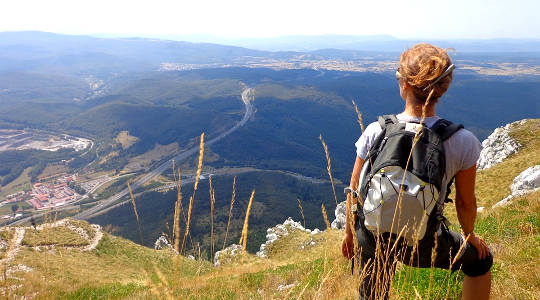
If Earth is a school, then what does graduation feel like? What’s waiting for you on the mountaintop? Could your life be more mysterious than you can see from the valley of conventional awareness? Since ancient times, mystics and shamans have consulted with oracles and sought to communicate with the spirit world, while countless others have simply gazed up into the night sky or looked deep within to find answers.
I relate the story of my own spiritual journey in Way of the Peaceful Warrior. Many readers have told me that the book changed their lives. Few are able to articulate exactly what changed, but I believe it comes down to this: The story describes my shift from a narrow focus on personal success to an understanding of life’s bigger picture — and readers share that experience.
In the film adaptation of my first book, the full scope of the quest gives way to a smaller story about a young gymnast who learns nuggets of wisdom, culminating in a deeper understanding of the power of the present moment.
But this epilogue, like my first book, takes us beyond self-improvement to what may be humanity’s ultimate purpose — transcendence, usually defined as rising above or beyond. Any dictionary definitions fall short, because the experience, by its very nature, goes beyond conventional language and defies description, which is why Lao-tzu said, “Those who know do not speak [of it], and those who speak [of it] do not know.”
Facilitating An Understanding
Many of the sages and saints who have seen the light, or truth or reality as it is, have felt moved to provide clues, methods, metaphors, and paths pointing toward that which defies description. For example, Zen masters assign their students koans — riddles that can’t be solved by the rational mind (such as “What was your original face before you were born?”). The koan stretches the student’s awareness to leap beyond conventional mind to experience kensho, a breakthrough insight similar to, yet transcending, the “aha” experience of solving a more conventional riddle.
Zen koans are but one way to facilitate an awakening. Seeking to achieve a state of liberation or bliss, Sufi masters twirl and dance, while other seekers go on vision quests or ingest psychotropic substances; still others pray, contemplate, meditate, chant, or do practices involving breath and visualization. All for a glimpse of the transcendent.
Why do they bother? Isn’t this conventional world, and everyday life, enough? Perhaps transcendence doesn’t really exist except in the minds of true believers. Maybe ideas about the divine, and soul and spirit, and heavenly realms during or after physical death, are fanciful notions or flights of imagination. Our souls may or may not ascend to a heavenly realm, and even if we have past or future lives, we’re not likely to remember any of them with certainty, but we certainly do have to live this life.
Yet, in moments of awe and wonder — or more often when tragedy strikes, in times of great dislocation, distress, or when dealing with mortality — we are moved to ask the existential questions, such as “Why live if we must die?” and “What is my purpose here?” At times like these, the possibility of a divine intelligence, a prime mover or creative source and substance of the universe, can seem not only appealing but somehow self-evident. (As one religious scholar put it, “There’s God, then there’s not paying attention.”)
Glimpsing The Truth That Sets Us Free
Innumerable sages, mystics, and clerics in holy orders, who have devoted their lives to the quest for Spirit, God, or Truth, report how the “gates of heaven” appeared as they broke through the illusions of conventional mind to glimpse the truth that sets us free — a vision of the eternal and absolute Consciousness at the heart of our existence. They call us to turn our eyes upward toward our spiritual purpose even as we live our day-to-day lives; to merge heaven and earth with a leap of faith; to live with our heads in the clouds and our feet on the ground.
Most of the time conventional reality monopolizes our attention. We have daily tasks, duties, pleasures, and problems. We play out our dramas in the theater of gain and loss, desire and satisfaction. We pursue fulfillment, pleasure, and success, trying to make life work out according to our hopes and wishes. No matter what our degree of success or status, we experience attachment, anxiety, and disappointment in this world of change. This realization can set in motion a sincere and open-minded quest to realize a higher or transcendent truth.
Seeking the Transcendent While Embracing Our Conventional World
One way to understand the difference between conventional and transcendental awareness is to imagine the experience of lying on your belly down in a valley and examining stones, weeds, and grass versus standing on a mountain peak and surveying the panorama below. Both experiences have value, but only one provides the bigger picture.
To enjoy the panorama, we need to make the climb. But in daily life, this shift of awareness can take place in an instant. When we make this shift — remembering life’s bigger picture even as we function in everyday life — the conventional and transcendental worlds become one.
Seeking the transcendent does not mean rejecting our conventional world but rather embracing it fully, releasing our resistance, attachments, and expectations. As we do, we experience a lighthearted wisdom; we take ourselves and our dramas less seriously.
A momentary glimpse of the transcendent can restore our humor and refresh our spirits, which is why many awakening individuals consider our spiritual purpose the ultimate quest even as we do the laundry, care for children, and work for a better world.
Where Do Freedom and Joy Reside?
Freedom and joy do not reside elsewhere; they are right here, right now, right before our eyes. All paths lead toward an awakening where theories and concepts, models and maps all dissolve into the eternal present, into reality as it is.
Once we come full circle and complete this “journey without distance,” we recognize that we’ve been here before. We have always been right here, precisely where we stand, in this arising moment of absolute mystery and divine perfection.
In quiet moments, many of us are touched by the wonder, miracle, and mystery at the heart of our existence. As expressed in the epigraph below, from my novel The Journeys of Socrates, my old mentor, after an arduous odyssey, comes to the following conclusion, which speaks to a realization awaiting us all.
When I was young, I believed that life
might unfold in an orderly way,
according to my hopes and expectations.
But now I understand that the Way winds like a river,
always changing, ever onward, following God’s gravity
toward the Great Sea of Being.
My journeys revealed that the Way itself creates the warrior;
that in the fullness of time,
every path leads to peace, and every choice to wisdom.
And that life has always been, and will always be,
arising in Mystery.
— DAN MILLMAN, The Journeys of Socrates
Reprinted with permission of the publisher, HJ Kramer/
New World Library. ©2011, 2016. www.newworldlibrary.com
Article Source
 The Four Purposes of Life: Finding Meaning and Direction in a Changing World
The Four Purposes of Life: Finding Meaning and Direction in a Changing World
by Dan Millman.
Click here for more info and/or to order this book (hardcover) or paperback (2016 reprint edition).
About the Author
 Dan Millman — a former world champion athlete, coach, martial arts instructor, and college professor — is the author of numerous books read by millions of people in twenty-nine languages. He teaches worldwide, and for three decades has influenced people from all walks of life, including leaders in the fields of health, psychology, education, business, politics, sports, entertainment, and the arts. For details: www.peacefulwarrior.com.
Dan Millman — a former world champion athlete, coach, martial arts instructor, and college professor — is the author of numerous books read by millions of people in twenty-nine languages. He teaches worldwide, and for three decades has influenced people from all walks of life, including leaders in the fields of health, psychology, education, business, politics, sports, entertainment, and the arts. For details: www.peacefulwarrior.com.




























